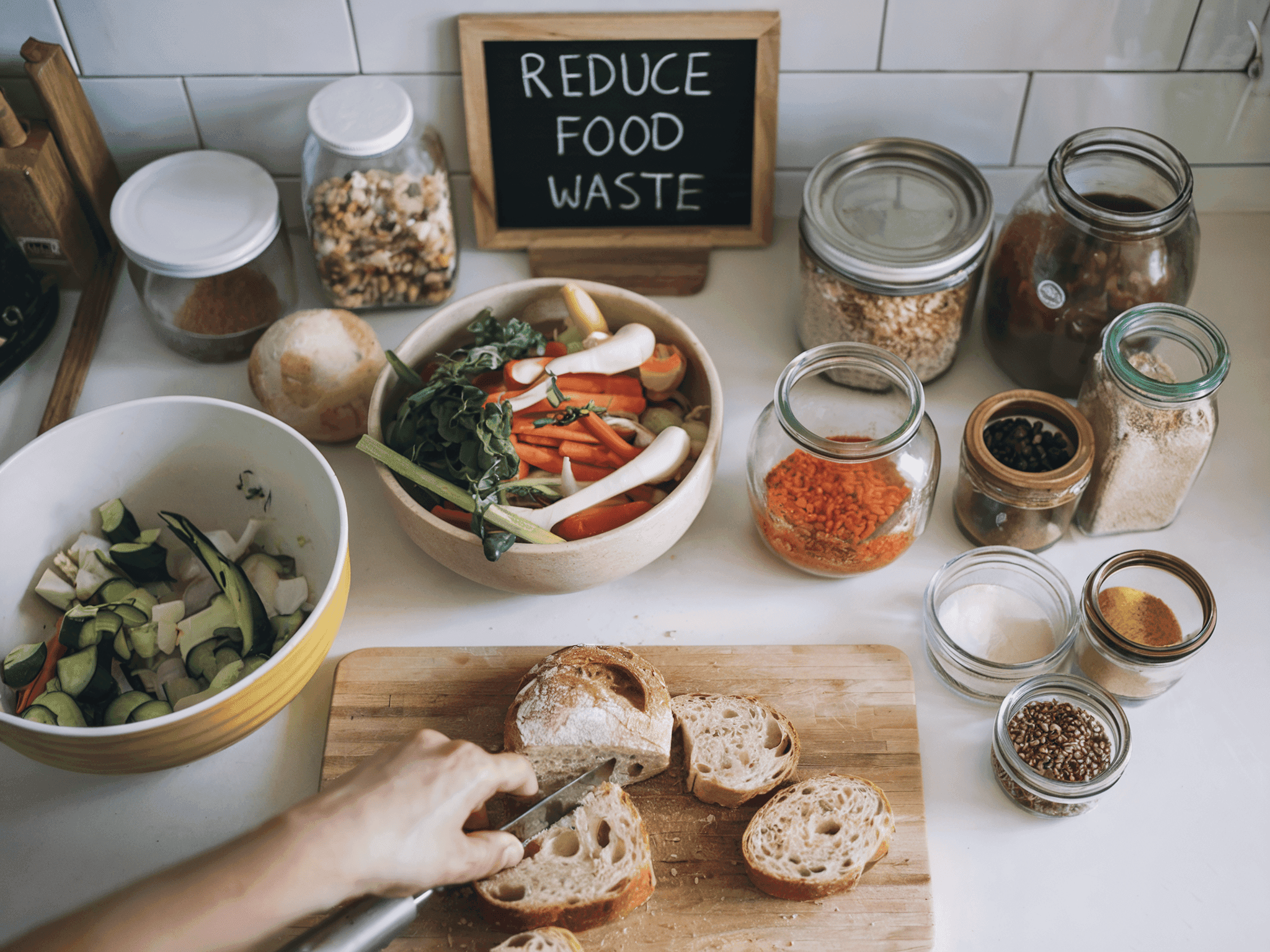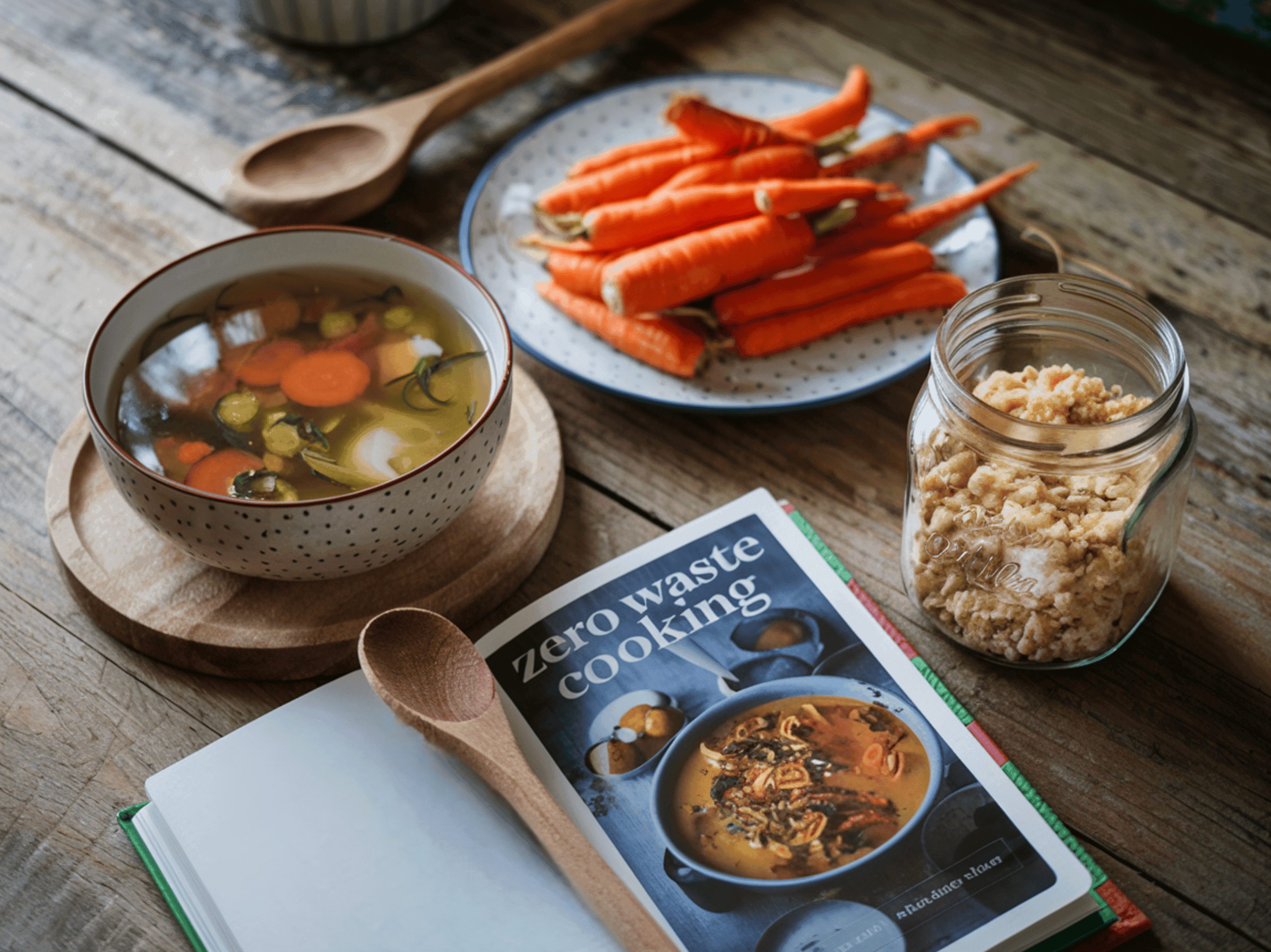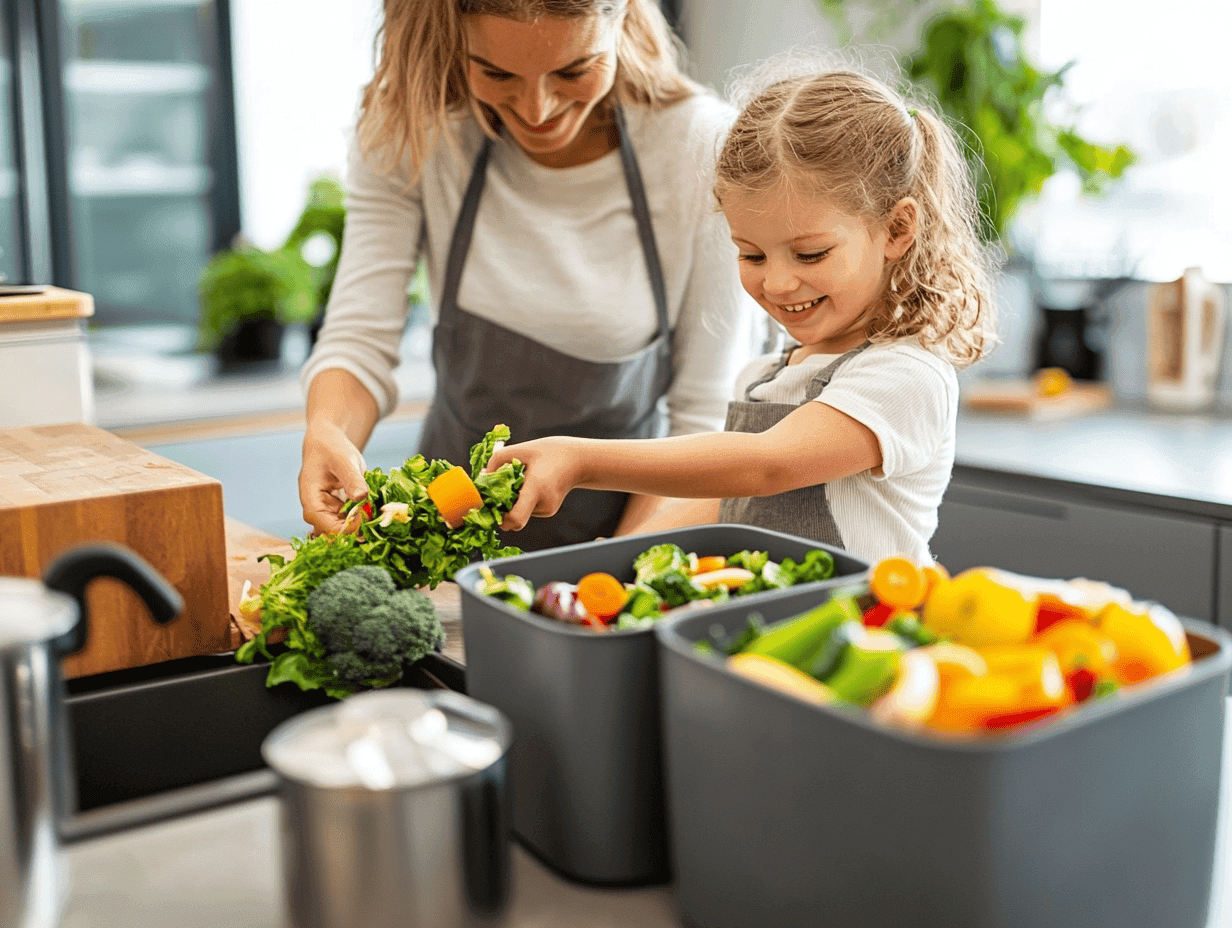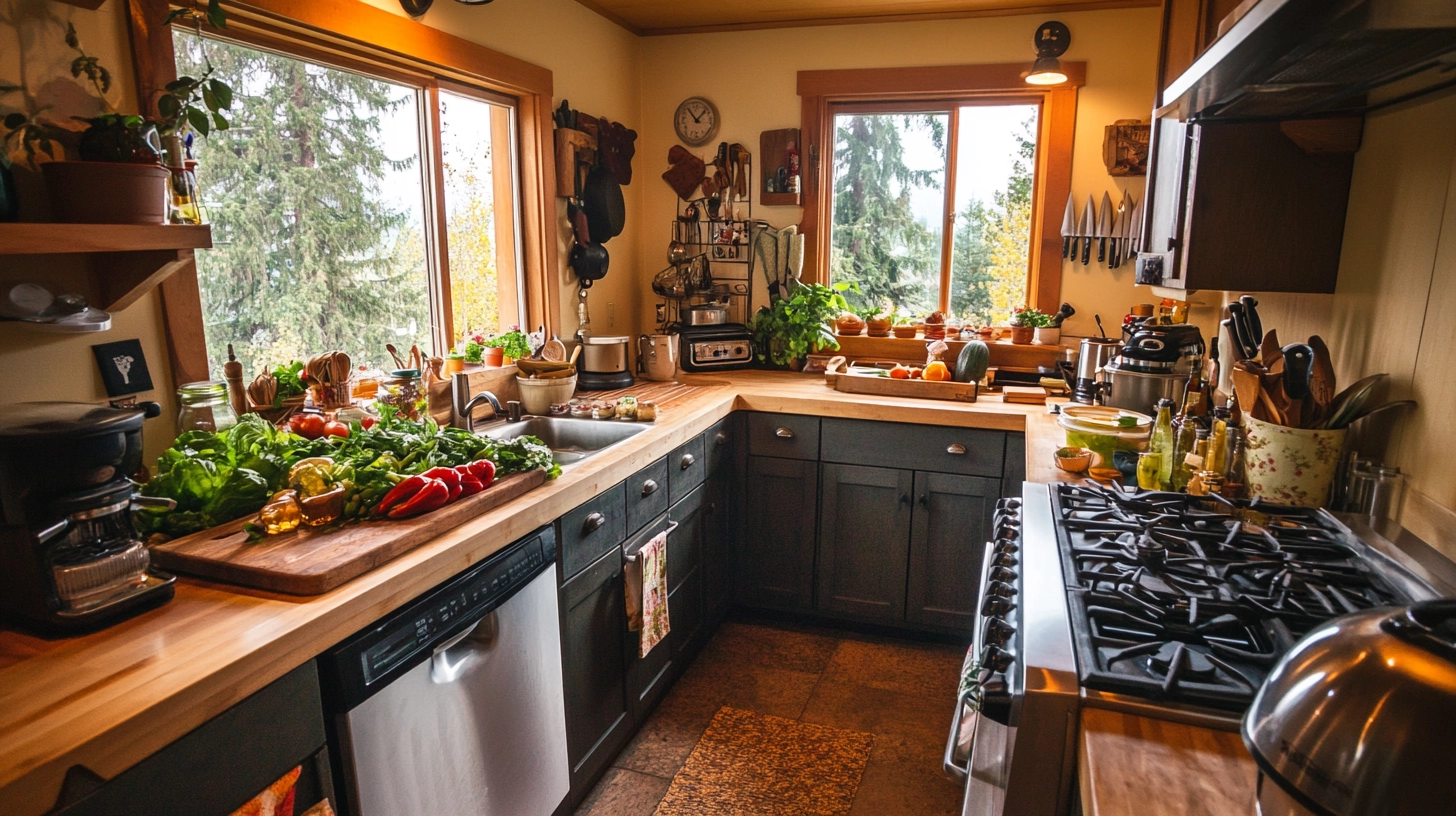Zero waste meals are a sustainable approach to cooking that minimizes food waste by using every part of an ingredient, from root to stem and nose to tail. But what are zero waste meals really about? They focus on reducing kitchen waste, making the most of fresh produce, and repurposing leftovers creatively.
Every year, millions of tons of food are wasted, leading to environmental harm and unnecessary spending. However, by adopting zero waste cooking, you can significantly cut down on waste while saving money and enjoying healthier meals.
In this guide, we’ll answer the question, what are zero waste meals, and explore their benefits, meal-planning strategies, and essential recipes. We’ll also cover tips to make sustainable cooking a habit so you can reduce waste effortlessly. Ready to get started? Let’s dive in!
In This Article
Understanding Zero Waste Meals
What is Zero Waste Cooking?
At its core, zero waste cooking is about using every possible part of an ingredient, leaving behind little to no food waste. Instead of discarding vegetable peels, meat bones, or stale bread, these components are repurposed into broths, sauces, and creative dishes.
Unlike conventional meal prep, which often leads to excess scraps and unused portions, zero waste meals focus on efficiency. Every element of a food item is seen as valuable, contributing to a more sustainable way of cooking and eating.
The Philosophy Behind Zero Waste Meals
The concept of zero waste meals aligns with the broader zero waste lifestyle, which aims to reduce waste across all aspects of daily life. This movement is driven by three key principles:
- Reduce: Buy only what you need and avoid excessive packaging.
- Reuse: Find creative ways to repurpose ingredients rather than discarding them.
- Recycle & Compost: Turn unavoidable food scraps into compost or other useful materials.
By applying these principles in the kitchen, we can significantly cut down on waste while fostering a deeper appreciation for food.
How Zero Waste Meals Help Reduce Food Waste
Food waste isn’t just about tossing leftovers—it’s a global crisis. According to the UN Food and Agriculture Organization (FAO), nearly one-third of all food produced worldwide goes uneaten. That’s not just wasted food—it’s wasted water, energy, and labor.
Zero waste cooking tackles this issue by encouraging mindful eating habits, such as:
- Using vegetable scraps to make flavorful homemade broth.
- Freezing overripe fruits for smoothies or baking.
- Transforming stale bread into croutons, bread pudding, or breadcrumbs.
- Cooking “root-to-stem” by incorporating beet greens, carrot tops, and herb stems into meals.
The Benefits of Zero Waste Meals

Adopting zero waste meals isn’t just good for the environment—it’s great for your wallet and well-being, too! From cutting down on food waste to eating fresher, more wholesome meals, the benefits of sustainable cooking are endless.
Environmental Benefits: Reducing Food Waste & Carbon Footprint
Every time food is thrown away, we’re wasting not just the food itself but also the resources used to produce it—water, energy, and labor. Shockingly, food waste accounts for nearly 8-10% of global greenhouse gas emissions.
By embracing zero waste cooking, you contribute to:
- Less landfill waste: Food scraps decompose in landfills, releasing methane, a potent greenhouse gas.
- Lower resource consumption: Wasting food means wasting water and energy used in its production.
- Sustainable agriculture: When demand shifts toward mindful eating, food production becomes more efficient.
A great way to start reducing your carbon footprint is by using vegetable scraps, peels, and cores to make homemade stocks instead of buying processed alternatives.
Economic Benefits: Saving Money & Maximizing Ingredients
Food waste isn’t just bad for the planet—it’s also a drain on your budget. The average household wastes hundreds of dollars worth of food each year. By making the most of every ingredient, zero waste meals help you stretch your grocery budget further.
- Meal planning prevents overbuying and ensures that all food is used efficiently.
- Repurposing leftovers into new dishes reduces food waste while keeping meals exciting.
- Buying in bulk and storing food properly helps extend the shelf life of ingredients.
For budget-friendly zero waste recipes, check out Zero Waste Recipes & Sustainable Cooking.
Health Benefits: Fresh, Whole Foods & Nutritional Advantages
Zero waste cooking encourages using fresh, whole foods rather than heavily processed options. By utilizing seasonal and local produce, you enjoy meals that are both healthier and more flavorful.
- More fiber and nutrients: Using vegetable skins, stems, and leaves maximizes nutrient intake.
- Less reliance on processed foods: Cooking from scratch means fewer preservatives and additives.
- Mindful eating habits: Planning meals encourages balance and variety in your diet.
If you’re looking for a nutritious, waste-free meal idea, try this Carrot Top Chimichurri Recipe, which repurposes often-discarded carrot greens into a delicious sauce!
Key Principles of Zero Waste Cooking
Cooking sustainably starts with understanding zero waste principles. From making the most of every ingredient to smart shopping, these habits will transform the way you cook.
Using Every Part of an Ingredient: Root-to-Stem & Nose-to-Tail Cooking
One of the biggest sources of food waste is unused parts of fruits, vegetables, and meat. Instead of tossing them, why not repurpose them into delicious meals?
- Root-to-stem cooking: Use broccoli stems, carrot tops, and beet greens in stir-fries, pestos, or soups.
- Nose-to-tail eating: If you consume meat, use bones for broth, organ meats in dishes, and fat for cooking.
- Citrus peels & herb stems: These add great flavor to infused water, sauces, or homemade seasoning blends.
By thinking creatively, you’ll see every ingredient as an opportunity rather than waste!
Composting Scraps for Sustainability
Even with the best efforts, some scraps—like eggshells, coffee grounds, and onion skins—aren’t always edible. Instead of throwing them away, compost them to enrich the soil and support plant growth.
How composting helps:
- Reduces landfill waste and methane emissions.
- Creates nutrient-rich soil for gardening.
- Encourages a circular food system by returning nutrients to the earth.
If you don’t have space for a compost bin, look for community compost programs or use indoor composting methods like bokashi bins.
Smart Shopping: Buying in Bulk & Avoiding Packaging
Zero waste cooking starts before you even step into the kitchen. Making mindful choices at the grocery store ensures you create less waste from the get-go.
- Buy in bulk to reduce packaging waste—bring your own containers when possible.
- Choose fresh, whole foods instead of processed options with excessive packaging.
- Plan meals ahead to avoid impulse purchases and reduce food spoilage.
How to Plan a Zero Waste Meal
Meal planning is a powerful tool for reducing food waste. By taking a strategic approach to grocery shopping and meal prep, you can ensure that every ingredient gets used efficiently. So, how can you start planning zero waste meals like a pro?
Step 1: Assessing What You Already Have
Before making a shopping list, take inventory of your kitchen. Check your fridge, pantry, and freezer for ingredients that need to be used up.
- Look for items close to expiration—these should be prioritized in upcoming meals.
- Identify versatile ingredients that can be used across multiple dishes.
- Group similar ingredients to prevent duplicate purchases.
Using what you already have before buying more reduces waste and saves money.
Step 2: Meal Planning to Reduce Waste
Once you know what’s available, create a meal plan that makes the most of those ingredients. Consider:
- Batch cooking: Preparing meals in bulk reduces unused ingredients.
- Multi-purpose ingredients: Plan meals that share ingredients to prevent leftovers from going bad.
- Flexible recipes: Choose dishes where you can swap ingredients based on what you have.
For inspiration, check out these zero waste recipes and sustainable cooking tips.
Step 3: Proper Food Storage Techniques
Storing food correctly extends its shelf life and prevents spoilage. Here’s how:
- Use airtight containers to keep produce and leftovers fresh.
- Freeze excess food before it spoils—chopped veggies, herbs, and even bread can be frozen.
- Store fruits and vegetables properly: Some do best in the fridge, while others should be left at room temperature.
Proper storage minimizes food waste and ensures ingredients stay fresh longer.
Step 4: Creative Ways to Use Leftovers
Leftovers aren’t boring—they’re opportunities for new meals! Instead of letting them sit in the fridge, get creative:
- Blend leftover veggies into soups or sauces.
- Use roasted meat in sandwiches, salads, or tacos.
- Repurpose stale bread into croutons, breadcrumbs, or French toast.
Planning ahead helps reduce waste while making meals easier and more cost-effective.
Essential Zero Waste Recipes

Cooking with a zero waste mindset doesn’t mean compromising on flavor. In fact, some of the most delicious dishes come from repurposing ingredients that might otherwise go to waste. Here are a few staple recipes to get you started.
Zero Waste Soups & Stocks: Turning Scraps into Flavorful Broth
Homemade broth is an easy way to use up vegetable scraps, meat bones, and herb stems. Instead of buying stock in cartons (which create packaging waste), make your own.
Basic Zero Waste Vegetable Stock Recipe:
- Collect veggie scraps—onion skins, carrot tops, celery ends, and garlic peels.
- Add them to a pot with water, salt, and herbs.
- Simmer for an hour, strain, and store in the fridge or freezer.
This broth adds depth to soups, stews, and risottos!
Creative Use of Vegetable Peels & Stems in Meals
Many vegetable parts we discard are packed with nutrients and flavor. Instead of tossing them, use them creatively:
- Carrot peels can be roasted into crispy chips.
- Broccoli stems can be spiralized into noodles or blended into soups.
- Cauliflower leaves can be stir-fried like cabbage.
Looking for a way to use carrot tops? Try this Carrot Top Chimichurri Recipe!
Repurposing Stale Bread into Delicious Dishes
Bread is one of the most commonly wasted foods, but it doesn’t have to be! If it’s gone stale, repurpose it into something tasty:
- Homemade croutons: Cube the bread, toss with olive oil and spices, then bake.
- Bread pudding: Stale bread makes a fantastic base for a sweet, custardy dessert.
- Breadcrumbs: Blend stale bread into fine crumbs for coating or thickening soups.
DIY Zero Waste Snacks & Desserts
There are plenty of delicious zero waste snacks you can make with leftover ingredients:
- Banana bread made from overripe bananas.
- Fruit peel crisps by baking apple or citrus peels with cinnamon.
- Leftover oatmeal cookies using cooked oats from breakfast.
Common Challenges & How to Overcome Them
Switching to zero waste meals is rewarding, but like any lifestyle change, it comes with challenges. Whether it’s a busy schedule or a lack of access to bulk stores, here’s how to overcome common obstacles and make zero waste cooking work for you.
Busy Schedules: How to Make Zero Waste Cooking More Convenient
One of the biggest concerns people have is time. Cooking from scratch and reducing food waste may seem overwhelming, especially with a hectic lifestyle. But with a little planning, it’s easier than you think!
- Batch cook: Prepare meals in advance and store them in portions for quick reheating.
- Use simple, versatile recipes: Choose meals that allow ingredient swaps based on what’s available.
- Freeze extra portions: Soups, sauces, and chopped veggies can be frozen to save time later.
By making small adjustments, you can enjoy zero waste meals without adding stress to your routine.
Lack of Access to Bulk or Sustainable Stores
Not everyone has access to farmers’ markets or zero waste grocery stores. But that doesn’t mean you can’t embrace sustainable cooking!
- Choose unpackaged produce whenever possible.
- Buy larger quantities to reduce packaging waste.
- Use reusable produce bags and storage containers.
Even if bulk shopping isn’t an option, making mindful choices at your local supermarket can still make a big impact.
Overcoming the Habit of Overbuying Groceries
Many of us buy more food than we need, leading to waste. To break the cycle:
- Make a shopping list based on a meal plan.
- Avoid impulse purchases—stick to what’s necessary.
- Store perishables properly to extend their shelf life.
By buying only what you’ll use, you’ll waste less and save money in the process.
FAQs – Answering Common Questions

Can Zero Waste Cooking Work for a Large Family?
Absolutely! While cooking for a large household can seem wasteful, zero waste meal planning can actually help you save money and reduce food waste.
- Cook in bulk and use leftovers wisely.
- Involve family members in meal prep to minimize waste.
- Use every part of an ingredient across multiple meals.
By being mindful of portions and storage, you can make zero waste cooking practical for any family size.
Is Zero Waste Cooking More Expensive?
Not at all! In fact, it often saves money. By using all parts of ingredients, repurposing leftovers, and avoiding unnecessary purchases, you’ll spend less in the long run. Plus, making meals from scratch is usually cheaper than buying pre-packaged foods.
How Do You Store Zero Waste Ingredients Properly?
Proper storage is key to keeping food fresh and reducing waste. Here’s how:
- Leafy greens: Store in a damp cloth inside a container in the fridge.
- Root vegetables: Keep in a cool, dark place to extend their life.
- Herbs: Place stems in water like flowers or chop and freeze them for later use.
Learning how to store food properly will help you get the most out of your groceries.
Can You Do Zero Waste Cooking Without Composting?
Yes! While composting is a great way to handle unavoidable scraps, you can still reduce waste without it.
- Use vegetable scraps for broths or sauces.
- Repurpose peels, stems, and seeds in creative ways.
- Donate excess food to local food banks if possible.
Tips for Making Zero Waste Cooking a Habit
Adopting zero waste meals isn’t just about a one-time effort—it’s about building lasting habits that reduce food waste every day. By making small, sustainable changes, you can create a more eco-friendly kitchen without much extra effort.
Start Small & Build Sustainable Habits
Trying to go completely zero waste overnight can feel overwhelming. Instead, start with small steps:
- Use up what you already have before buying more groceries.
- Commit to one waste-free meal per week and increase gradually.
- Get creative with leftovers instead of throwing them out.
The key is to make small changes that feel natural rather than forcing drastic shifts all at once.
Get the Whole Household Involved
Reducing waste is easier when everyone participates. Whether you live with family, friends, or roommates, encourage them to adopt zero waste cooking habits too.
- Assign food prep tasks to each member to make cooking efficient.
- Teach kids how to use food scraps in fun, creative ways.
- Set up a compost bin together to make sustainability a shared goal.
When the whole household works toward reducing waste, the impact is much greater!
Make Zero Waste Cooking Fun & Creative
Cooking should never feel like a chore! Turning food scraps into new dishes can be an exciting challenge. Try:
- Theme nights, like “fridge clean-out” meals, where you use only what’s available.
- Experimenting with new ways to use peels, stems, and leftovers.
- Following zero waste cooking challenges to stay motivated.
By making it fun, you’ll be more likely to stick to zero waste meals long-term.
The Future of Zero Waste Cooking & Final Thoughts
As more people become aware of the impact of food waste, zero waste meals are gaining popularity worldwide. With better awareness, technology, and sustainable innovations, the future of cooking looks greener than ever.
The Growing Movement Toward Sustainable Eating
Restaurants, grocery stores, and households are embracing zero waste cooking. More chefs are using root-to-stem and nose-to-tail techniques, while food brands are finding innovative ways to cut waste. Some exciting trends include:
- Upcycled food products: Companies are turning food waste into new snacks and ingredients.
- Sustainable packaging: More brands are ditching plastic for compostable or reusable options.
- Food rescue apps: Digital platforms help people buy surplus food at discounted prices.
With ongoing efforts, reducing food waste will soon become the norm rather than the exception.
Final Thoughts: Every Meal Counts
So, what are zero waste meals? They’re more than just a trend—they’re a lifestyle shift that benefits the planet, saves money, and encourages mindful eating. Every small step you take, whether it’s using food scraps creatively or shopping more consciously, makes a difference.
By embracing zero waste meals, you’re not just reducing waste—you’re creating a more sustainable, thoughtful, and delicious way of cooking. So why not start today? Your kitchen (and the planet) will thank you! 😊

